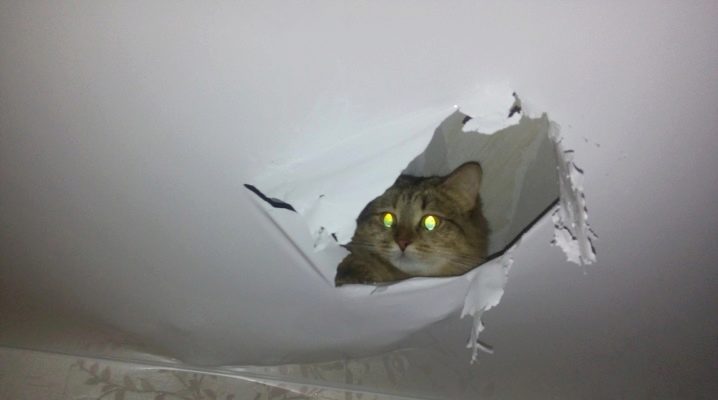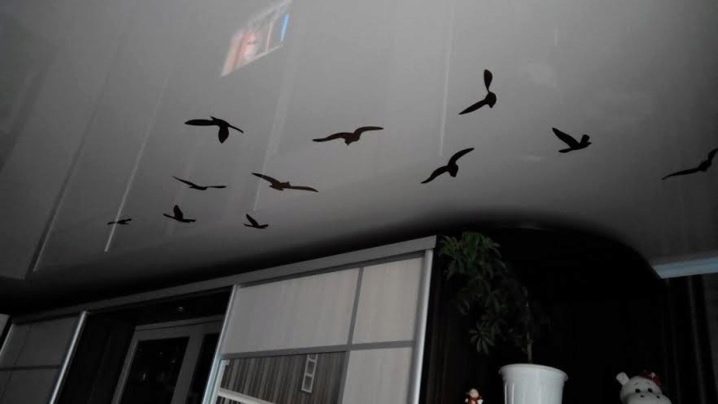How to remove a hole in a stretch ceiling with your own hands?

Stretch ceilings are the most popular option for finishing the ceiling, used both in houses of modern construction, and in "Khrushchev" or "old fund". Such a finish allows you to hide bumps, cracks, poor painting and the consequences of leaks. Even new plasterboard ceilings do not give confidence that your ceiling will be ideal in 2-3 years, because often the joints begin to crumble, and cracks may appear when the building "shrinks" after construction.


Damage features
A stretch ceiling avoids frustration and stays flawless for years. True, a hole may appear on such a ceiling. The reasons for its appearance can be very different: a champagne cork, unexpectedly "shot" at the festive table, a toy thrown high by a child with an acute angle (as well as darts, children's pistols and arrows), installation of a lamp or curtains. Unfortunately, electrical wiring and electrical appliances can also damage the stretch ceiling.

Sometimes it seems that a small hole will not do much harm, especially if it is not in a prominent place. Be careful: repairing even minor damage to the stretch ceiling is required, because over time, the fabric or PVC film will sag at the gap, and the size of the hole will increase.
What to do? Of course, do not panic and remember that most often you can patch up the hole with your own hands. According to the owners of the premises with stretch ceilings, almost every one of them faced a similar problem at least once.


So:
- Evaluate whether the resulting defect can be attributed to the warranty case. Poor installation, factory defects, discrepancy along the seam - all these points are usually spelled out in the contract that you entered into when installing the ceiling. If holes are formed in the ceiling along the perimeter of the walls, then the use of defective material or poor-quality installation is evident.


The discrepancy in the seams is a reason to file a claim with the contractor, because this is a sign of incorrect cutting and "constriction". If your case is covered under warranty, provide the manufacturer with the opportunity to correct the error.

- If there are several holes in the ceiling, and they are located in different places, then the best solution would be a complete replacement of the stretch fabric.
- If, nevertheless, the hole has arisen through your fault, then, first of all, decide which ceiling you will have to work with - from PVC material or fabric.
- If you suspect that the edges of the hole may come apart, then secure them with tape.
- Before applying any patches, degrease the area to be repaired. Do not use alcohol or solvents, they can damage the ceiling. It is best to use special products for the maintenance of stretch ceilings or a solution of laundry soap.

So, you know the type of ceiling, decided on the complexity of the repair, adequately assessed the damage and are ready to proceed with the repair

Repair of the canvas
As a result of careless use of an electrical tool, the stretch ceiling may be punctured. If you accidentally perforated the cloth with a screwdriver or a tester, then you can repair such damage without inviting specialists. In the event of a puncture, there is no need to dismantle the entire ceiling.


A small circle cut from PVC film, similar in quality to your ceiling film, will be invisible from a distance of 2.5 meters. Therefore, feel free to glue the puncture with such a small circle or square, while using glue for PVC materials or vinyl wallpaper.
A wide range of adhesives is presented in hardware storestherefore it is important to read the enclosed instructions carefully. Nevertheless, all these tools have one thing in common that must be borne in mind: all PVC adhesives set extremely quickly, as a result of which any delay in working with the patch can lead to repeated (and more difficult) repairs.

Stretch fabric ceiling is durable, but a puncture can occur in it. As you know, such ceilings consist of a base (polyester canvas) and a shell. If only the shell is punctured, then a drop of silicone sealant can fix the problem. If the damage touches the base, then the puncture must be sewn up with a thin thread (it is better to choose a synthetic one of a suitable color).
From fabric
It is easier to repair a fabric ceiling than a PVC ceiling. A small hole or incision can be simply sewn up and painted. A patch is required for a large hole. Important: we coat the patch with colorless glue (ideally, glue based on cyanoacrylate) and insert it into the hole.
Smooth the canvas carefully. We glue the edges of the patch with special care, give it time to dry and paint over with the desired color.

One of the "patch" options - a beautiful applique (sticker), which can be purchased at specialty hardware stores. There are many options for such stickers - flowers, clouds, birds, so it will not only eliminate damage, but also decorate the interior. In some cases, to install a patch or applique, the ceiling sheet must be dismantled and reinstalled. If you doubt the success of your DIY repair, you should invite professionals.
If the traces of repair are very noticeable or if you are tired of the applications that hide the gap, you can completely paint the stretch ceiling.

PVC
For a PVC ceiling, the location of the damage is important. A small hole no more than 1.5 cm from the fastening strips can be removed by pulling up the PVC material. This option is only suitable for "non-tightened" ceilings, allowing you to pull the hole up to the plank and secure the material. To prevent the material from tearing even further, secure the edges of the hole with masking tape.
If tightening is a complicated procedure, then the fixing plate closest to the hole must be removed. Next, we heat the surface of the PVC material with an ordinary hair dryer and stretch it so that the holes are no longer visible. Install the fastening bar back.

It is already much more difficult to seal a hole formed far from the wall. Experts recommend installing a spot light device in the place of the defect. To do this, a reinforcing ring of a suitable size is installed under the lamp, fixing it with a special glue for PVC materials. Modern technologies make it possible to install a luminaire that is turned on with a remote control, so wiring is not a prerequisite. You can also install a false device, that is, it will not give light, but it will close the hole perfectly.
The next option is all kinds of decorative patches for PVC ceilings, which are made self-adhesive. One of the sides of such a patch is protected with a special film. If the applique is large, it is not recommended to remove the entire protective film at once, otherwise its edges may bend.

Defects beyond repair
Unfortunately, improper cutting or overstretched blade can lead to seam divergence. Repair will not help here, you will have to install a new canvas. However, replacing the panel will be much cheaper without purchasing new fasteners and fixing strips.You need to contact the company that installed your ceilings for help.
A large hole from water or fire will also lead to replacement of the tensioner, no need to try to fix large-scale damage yourself. Do not forget that incorrectly or carelessly installed fastening strips can cause tears, gaps between the walls and the ceiling.

Tears from water
Unfortunately, cases of flooding of our apartments by neighbors from above are not so rare. PVC stretch ceiling is able to withstand a large mass of water, while the stretch fabric turns into an impermeable bag. PVC ceiling is waterproof and perfectly stretchable, so in most cases it can save your interior. To extract the water, you will have to make two neat punctures - one in the very center of the giant drop, and the other where there is no water. The easiest way is to make a puncture with an awl.


Most likely, after such a nuisance, the tension web will have to be replaced. However, if there is little water, the damaged elastic material can be restored to good condition.
Fabric ceiling can also be damaged by water - its large volumes will simply tear it apart at the attachment points, since it does not stretch. In addition, after the "water attack" on the fabric ceiling, most likely, ugly stains will remain, which, however, can be corrected by ordinary painting.


Useful Tips
In order for the stretch ceiling to serve you for many years, ordinary household neatness is enough.
Cutting the film or fabric is not so easy, so try to follow simple guidelines:
- Entrust the installation of electrical appliances and wiring to professionals.
- Use sharp objects carefully near a tightly stretched ceiling strip
- Do not try to clean the stretch ceiling with aggressive cleaning agents (including those containing chlorine).
- Use toys designed for outdoor play exclusively outdoors (even a regular rubber ball can damage the stretch ceiling).


- When installing ceilings, do not resort to the services of dubious would-be craftsmen who promise to do the job faster and cheaper. Refer to the services of professional teams that have proven themselves in the market for such services. Remember that you can always familiarize yourself with examples of work in the office or on the company's website. So, unprofessional installation is often to blame for the divergence of the seams and the sagging of the ceiling.
- Be careful when installing moldings or curtain rods. If the curtain rod is located close to the tensioning fabric, it makes sense to use cushioning spacers between the tensioning element and the sharp parts of the curtain rod.

How to repair a stretch ceiling with your own hands, see below.













The comment was sent successfully.